When building a new track car, drivers typically start by upgrading some usual suspects. Stock brakes are switched out for high-performance pads and discs that can withstand higher temperatures, and the suspension–including new springs, dampers, and bushings–is swapped for a setup that prioritizes speed over comfort. Limited slip differentials, air filters, intercoolers, turbochargers, and superchargers are other common mods and while they’ll go a long way toward improving a vehicle’s on-track credentials, they all lack one key ingredient: visibility. Even after dropping a few grand on upgrades, it can still be difficult to differentiate a stock model from its souped-up track-ready cousin; that’s where race seats come in.
These light, almost skeletal seats can make all the difference in setting a track car apart from the competition, lending any vehicle an aggressive appearance that speaks to the potential lurking just beneath the hood. But race seats are about more than just achieving a sporty look. They also serve a functional purpose by locking the driver in place and affording them better control of the vehicle during tight turns, rapid acceleration, and other scenarios one might face on an average day at the track. Let’s take a look at some of the pros and cons of race seats to see what they offer.

Pros of Using Race Seats
Weight
When you’re trying to build the fastest car possible it’s all about reducing weight. The less poundage your vehicle has to haul around, the better the power-to-weight ratio, which is part of why race seats are such a popular upgrade in the racing scene. A vehicle’s stock seats might weigh 50 lbs–up to 65 lbs in the case of a fully-electric luxury seat–but drivers can easily cut that figure in half by opting for lightweight race seats. Many racing seats weigh in at around 30 lbs, but if you’re looking to maximize your power, there are even fiberglass options that tip the scales at only about 15 lbs. Keep in mind that comfort and weight are almost always going to go hand in hand, meaning that the lighter your seats are, the less cozy they’ll be.
Control
For most drivers, the increased sense of control and security is the biggest reason to opt for race seats over the stock setup. Driver positioning is an important part of any successful ride, but it can be hard to maintain the correct position when you’re dealing with rapid acceleration, cornering forces, and other factors unique to track racing. Race seats are simply snugger than stock seats, holding a driver tight and ensuring that they don’t slide around while trying to perform a tricky maneuver or pass. That moment lost to readjustment can be the difference between taking the checkered flag and a DNF, which is why being secure in your seat is so important. Race seats also don’t typically recline like stock seats, keeping drivers in the optimal racing position at the cost of comfort.
Aesthetics
It might not be the biggest factor in the decision to switch over to race seats, but there’s no denying how cool they look. Often wrapped in black or red fabric, accented with contrast stitching, and splashed with logos, race seats can be a real statement piece for a car, one that lets passersby know they’re not dealing with some dull stock model. Race seats can give a driver some instant credibility because, no matter how they perform on the track, they demonstrate a willingness to sacrifice comfort and practicality to achieve their racing dreams.

Harnesses
One of the most practical advantages of race seats is the fact that they can accommodate full five- or six-point safety harnesses as opposed to the three-point seat belts that come standard. These safety harnesses should be one of the first upgrades a driver makes as they can dramatically improve health and safety outcomes in the event of a crash. Safety harnesses represent a major improvement over standard seat belts for numerous reasons. First off, they’re simply safer, with force-absorbing straps and increased surface area which means your weight will be more evenly distributed in case of a crash. Like race seats themselves, racing harnesses also keep you firmly planted in position, reducing the need to readjust to the ideal driving posture. They’re also easier to disengage, which is a big plus if you’re ever in a situation where you need to get out of the cockpit as quickly as possible.
Integrated Headrests
Head and neck safety should always be a top priority when behind the wheel of any track-worthy vehicle. While a seat belt–or safety harness–might keep your body in place, a driver’s head and neck are particularly susceptible to the type of rapid turning, accelerating, and decelerating forces that can easily result in whiplash or similar maladies. Race seats are designed with built-in headrests, improving overall safety by supporting a driver’s head from three sides. If you’re looking to take it one step further, race seats and safety harnesses are often compatible with head and neck support (HANS) devices which effectively tether a user’s helmet to the seats for an even more secure ride. It might sound a little complicated, but no driver’s racing career was ever improved by a risky head, neck, or shoulder injury.
Drawbacks of Using Race Seats
Comfort
A track car comes with many advantages over a stock model, but comfort typically isn’t one of them. Between suspension modifications, track-specific tires, and other racing-inspired mods, a track vehicle is almost always going to provide a rougher ride–the addition of racing seats won’t help one bit. Race seats are typically thinner, lighter, and generally less supportive than the standard issue seats that come in most of today’s vehicles. This approach might be fine for logging some laps around the track but could grow to be a real issue on longer rides or road trips. Before installing race seats, it’s important to be honest with yourself about how much time the vehicle is going to spend at the track. If you’re considering installing race seats in your daily driver, pause to think about the tolls they might take as you writhe around in stop-and-go traffic during your commute.

Ease of Access
Race seats aren’t only less comfortable to sit in, but they can also be much more difficult to access. The same high bolsters that keep you snug and secure while cornering can be a real impediment when it comes time to crawl out of the vehicle, especially if you suffer from hip or back issues. Combine this with the typically low-slung nature of track cars and you’ve got a recipe for discomfort, requiring you to limber up or hit a quick yoga class before you can contort your body into the seat.
Legitimacy
While they hold plenty of advantages when it comes to control, security, and aesthetics, race seats do carry one psychological pitfall: the risk of getting called out by other would-be racers. If you’re a stranger to your local track or racing scene, installing race seats can bring some scrutiny from those who consider themselves to be more legitimate racers. This isn’t necessarily a “con” as such, but can still represent a hurdle for some self-conscious drivers out there.
It’s also more than a little silly when you think about it. Car culture is for everyone. Unless someone’s name ends with Porsche, Buggatti, or Lamborghini, their opinion can largely be disregarded. If racing seats give your vehicle the look you’ve always dreamed of, then by all means go wild and don’t let yourself get deflated by the onlookers who are probably still telling themselves they have a chance to crack the F1 circuit.
Are Race Seats Worth It for You?
If you’re looking to bring your track days to the next level, racing seats are a great place to start. They’ll not only help you look the part, but can also make a big difference when it comes to control, safety, and your car’s weight. Sure, they might be less comfortable and a little more snug than the stock seats you’ll find in most vehicles, but that’s a small price to pay for a chance to shave a few precious seconds off your best lap time. Racing seats run the gamut from entry-level offerings to top-of-the-line models, making it easy to make the switch no matter what your budget might be. When it comes to interior upgrades, few things can make a vehicle feel like a more legitimate race car than the addition of race seats–unless you’re ready to weld a roll cage in place, but that’s another article for another time.

